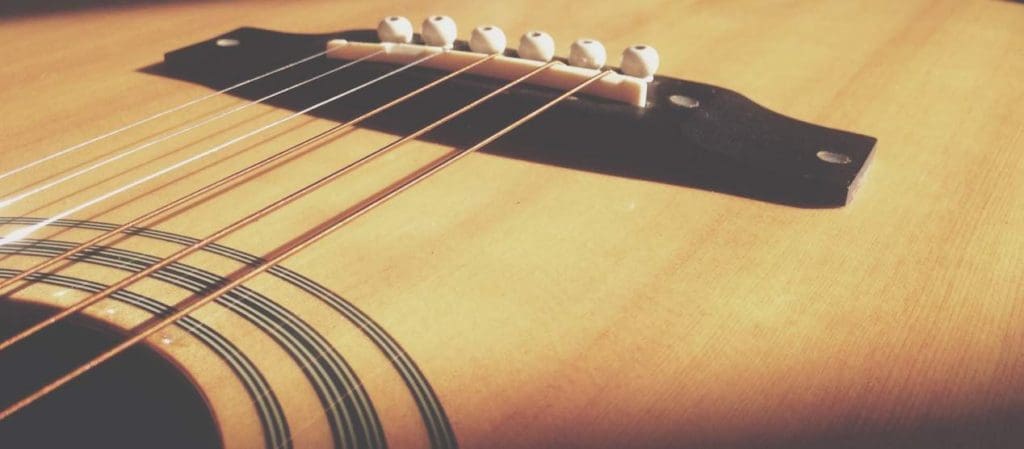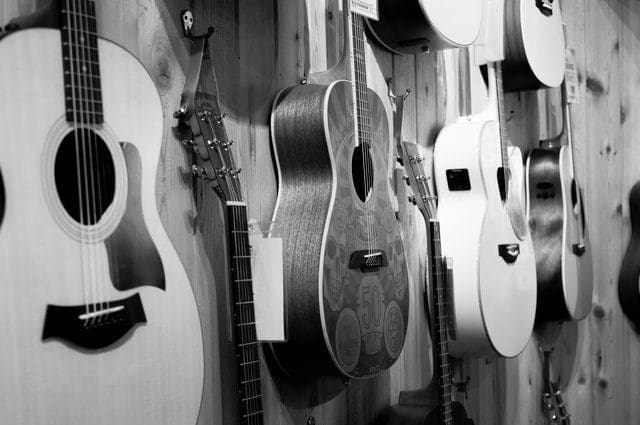Last update 5/2/2024
Welcome to the ultimate guide for electric guitars in 2023! We’ve scoured the market to bring you the finest selection of instruments that cater to every playing style and skill level. These guitars boast exceptional features, stunning tones, and ergonomic designs to make your playing experience truly unforgettable.
Table of contents
- Best Electric Guitars
- 1. Best Electric Guitar for Beginners: Yamaha Pacifica 112V
- Review
- 2. Best Budget Guitars: Squier Classic Vibe ’70s Stratocaster
- 3. Most Versatile Electric Guitar: PRS Custom 24
- 4. Best Shredding Guitar: Ibanez RG550
- 5. Best Electric Guitar for Clean Tones: Fender American Ultra Stratocaster
- 6. Best Electric Guitar for Rockabilly: Gretsch G6120T Players Edition Nashville
- 8. Fender American Professional Telecaster – The Quintessential Country Workhorse
- From Beginner to Pro: How to Choose the Perfect Electric Guitar in 2024
- Types of Electric Guitars
- Factors to Consider When Choosing an Electric Guitar
- Understanding Guitar Components
- Popular Electric Guitar Brands and Models
- Trying Out Electric Guitars
- Online Resources for Researching and Comparing Electric Guitars
- Important Accessories for Electric Guitar Players
- Tips for Maintaining and Caring for Your Electric Guitar
- Conclusion
Whether you’re looking for a guitar to ignite your passion for music or seeking an upgrade to enhance your performance. Our carefully curated list will help you make an informed decision. So, let’s dive in and discover the best electric guitars of 2024!
Best Electric Guitars
1. Best Electric Guitar for Beginners
2. Best Budget Guitars
3. Most Versatile Electric Guitar
4. Best Shredding Guitar
5. Best Electric Guitar for Clean Tones
6. Best Electric Guitar for Blues and Rock and Roll
7. Best Electric Guitar for Rockabilly
8. Best Electric Guitar for Country
1. Best Electric Guitar for Beginners: Yamaha Pacifica 112V
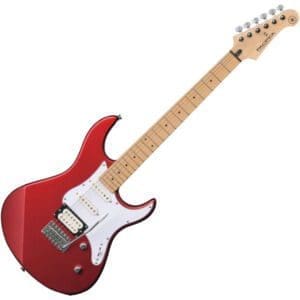

Specifications
Body: Alder
Neck: Maple
Fingerboard: Rosewood
Pickups: Two single-coil and one humbucker (HSS configuration)
Bridge: Vintage-style tremolo
Scale Length: 25.5″
Controls: Master Volume, Master Tone, 5-way pickup selector
Pros
Versatile tonal options
Smooth playability for beginners
Affordable and great value for money
Cons
Stock pickups may lack some high-end clarity
Player Suitability:
The Yamaha Pacifica 112V is the ideal choice for beginners and intermediate players. Its comfortable playability and versatile sound make it suitable for various musical genres.
Review
The Yamaha Pacifica 112V has long been praised for its outstanding value and playability, making it a top contender for beginners. Its HSS pickup configuration provides a wide range of tonal possibilities, allowing new players to explore different sounds as they progress in their musical journey. The guitar’s smooth maple neck and rosewood fingerboard make fretting a breeze, ensuring that even novice players can concentrate on honing their skills without discomfort.
The only potential drawback lies in the stock pickups. While decent, they may lack the clarity and punch desired by more advanced players. Nevertheless, the Yamaha Pacifica 112V remains a solid choice at its affordable price point.
Star Rating: ⭐⭐⭐⭐
2. Best Budget Guitars: Squier Classic Vibe ’70s Stratocaster
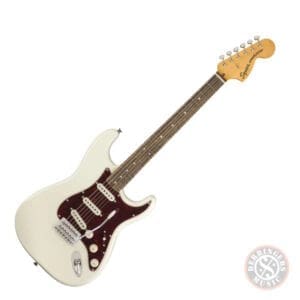

Specifications
Body: Poplar
Neck: Maple
Fingerboard: Indian Laurel
Pickups: Three custom Alnico single-coil
Bridge: Vintage-style synchronized tremolo
Scale Length: 25.5″
Controls: Master Volume, Tone 1 (Neck Pickup), Tone 2 (Bridge Pickup), 5-way pickup selector
Pros
Authentic vintage-style tones
Solid build and craftsmanship
Affordable with excellent value for money
Cons
Some players may prefer different tonewood options
Player Suitability:
The Squier Classic Vibe ’70s Stratocaster is perfect for players seeking a vintage-inspired guitar on a budget. Its versatility and rich tonal palette make it suitable for various musical styles.
Squier’s Classic Vibe ’70s Stratocaster pays homage to the golden era of rock ‘n’ roll without breaking the bank. Boasting a poplar body and maple neck, it delivers that classic Strat feel and resonance. The custom Alnico single-coil pickups reproduce the iconic vintage Strat tones, providing sweet, bell-like cleans and punchy, bluesy, overdriven sounds. Crafted with precision, this guitar ensures reliability and a smooth playing experience for budget-conscious musicians. The Squier Classic Vibe ’70s Stratocaster offers incredible value for money and remains a top choice for beginners and intermediate players alike.
See our Squire Classic Vibe 70s Stratocaster Review.
Star Rating: ⭐⭐⭐⭐
3. Most Versatile Electric Guitar: PRS Custom 24
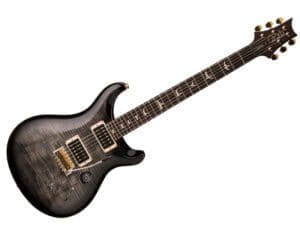

Specifications
Body: Mahogany
Top: Flamed Maple
Neck: Mahogany
Fingerboard: Rosewood
Pickups: 85/15 humbuckers
Bridge: PRS patented tremolo, Gen III
Scale Length: 25″
Controls: Volume, Tone, 5-way blade pickup switch, 3-way blade mode switch
Pros:
Exceptional build quality and aesthetics
Versatile tonal options with coil-splitting feature
Superb playability and comfortable design
Cons
Higher price point
Player Suitability:
The PRS Custom 24 is designed for professional musicians and enthusiasts who demand top-tier performance and versatility. Its incredible tonal range makes it suitable for almost any music genre.
The PRS Custom 24 stands as a true workhorse in the world of electric guitars. Crafted with precision and finesse, this instrument exudes elegance and offers many tonal possibilities. Combining a mahogany body with a flamed maple top provides rich, resonant tones with excellent sustain. Equipped with PRS’s renowned 85/15 humbuckers, this guitar can dish out pristine, clean tones, searing leads, and chunky rhythms.
The coil-splitting feature further extends its versatility, offering sparkling single-coil sounds when needed. The comfortable neck profile and smooth rosewood fingerboard make playing effortless, ensuring the guitar becomes an extension of the player’s creativity. Though it may be priced higher than some other options, the PRS Custom 24 delivers unparalleled performance, making it a top choice for serious musicians seeking a versatile instrument to fuel their artistic endeavors.
Our review for PRS Custom 24 Electric Guitar
Star Rating: ⭐⭐⭐⭐⭐
4. Best Shredding Guitar: Ibanez RG550


Specifications
Body: Basswood
Neck: Wizard 5-piece Maple/Walnut
Fingerboard: Maple
Pickups: DiMarzio Evolution humbuckers (HSH configuration)
Bridge: Edge tremolo bridge
Scale Length: 25.5″
Controls: Volume, Tone, 5-way pickup selector
Pros
Lightning-fast neck for effortless shredding
Powerful and versatile pickups
Tremendous sustain and stability
Cons
Basswood body may not appeal to everyone’s tonal preferences
Player Suitability:
The Ibanez RG550 is the ultimate choice for guitarists who love to shred, providing unmatched speed, precision, and tone. It’s a go-to option for metal and rock players seeking extreme performance.
The Ibanez RG series has always been synonymous with high-speed, technical playing, and the RG550 is no exception. Its slim and ultra-fast Wizard neck profile allows for blazing-fast solos and intricate riffing without any hindrance. The DiMarzio Evolution pickups deliver a high-output, searing tone that easily cuts through any mix. With the Edge tremolo bridge, dive bombs and pitch manipulations are a breeze, and the guitar stays in tune remarkably well, even after the most aggressive whammy bar abuse. T
he basswood body offers a balanced tone with a slight emphasis on the midrange, which works wonders for metal and rock styles but might not suit players seeking a warmer tonal palette. The Ibanez RG550 Genesis is an exceptional instrument built for shredders who demand precision, power, and speed on their musical journey.
Star Rating: ⭐⭐⭐⭐⭐
5. Best Electric Guitar for Clean Tones: Fender American Ultra Stratocaster
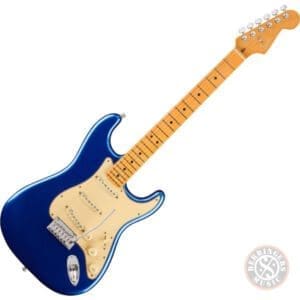

Specifications
Body: Alder
Neck: Maple
Fingerboard: Rosewood
Pickups: Ultra Noiseless Vintage Strat single-coils
Bridge: 2-Point Deluxe Synchronized Tremolo
Scale Length: 25.5″
Controls: Master Volume (S-1 switch), 2 x Tone, 5-way pickup selector
Pros
Exceptionally clean and clear tones
Noiseless pickups for studio-quality sound
Enhanced playability with the Modern “D” neck profile
Cons
Premium features come with a higher price tag
Player Suitability:
The Fender American Ultra Stratocaster caters to players who demand pristine clean tones for genres like jazz, country, and pop. Its advanced features and craftsmanship make it an excellent choice for professionals and tone purists.
The Fender American Ultra Stratocaster raises the bar for clean-tone performance with its Ultra Noiseless Vintage Strat pickups. These pickups retain the iconic Stratocaster sound while eliminating any unwanted hum and noise, delivering studio-quality clean tones that are perfect for intricate chord progressions and melodic playing.
The guitar’s alder body provides a balanced and resonant tonal foundation, while the 2-Point Deluxe Tremolo ensures smooth pitch control for subtle vibrato effects. The Modern “D” neck profile offers enhanced playability and comfort, making long hours of playing a breeze. Although it may be more expensive than entry-level options, the Fender American Ultra Stratocaster is a premium instrument that will satisfy even the most discerning players seeking pristine clean tones and top-notch craftsmanship.
See our review of the Fender Stratocaster Ultra Stratocaster
Star Rating: ⭐⭐⭐⭐⭐
6. Best Electric Guitar for Rockabilly: Gretsch G6120T Players Edition Nashville
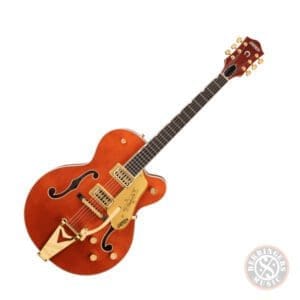

Specifications
Body: Laminated Maple
Neck: Maple
Fingerboard: Ebony
Pickups: High Sensitive Filter’Tron humbuckers
Bridge: Adjusto-Matic with Bigsby B6GP tailpiece
Scale Length: 24.6″
Controls: Master Volume, Master Tone, 3-way pickup selector
Pros
Vintage-style tones with a modern twist
Iconic rockabilly aesthetics
Smooth playability and versatile sound
Cons
Some players may prefer a shorter scale length
Player Suitability
The Gretsch G6120T Players Edition Nashville is tailor-made for rockabilly players seeking authentic vintage tones, stylish looks, and contemporary playability.
Gretsch guitars have been at the heart of rockabilly music for decades, and the G6120T Players Edition Nashville continues that legacy.
This guitar boasts a laminated maple body that delivers that characteristic twangy sound associated with rockabilly music.
The High Sensitive Filter’Tron humbuckers capture the vintage tones with clarity and definition, while the Bigsby tremolo adds a touch of nostalgia for those dreamy bends and shimmers. The sleek ebony fingerboard and comfortable neck profile ensure that players can easily glide up and down the fretboard, supporting their intricate picking and chord progressions.
While some players may prefer a shorter scale length, the Gretsch G6120T Players Edition Nashville remains an excellent choice for rockabilly enthusiasts, embodying the timeless spirit of the genre in both sound and style.
Star Rating: ⭐⭐⭐⭐⭐
8. Fender American Professional Telecaster – The Quintessential Country Workhorse
The Fender American Professional Telecaster is one of the most iconic and beloved guitars in the country music realm. With its signature twang, remarkable versatility, and exceptional craftsmanship, it has become a go-to choice for country players of all levels.
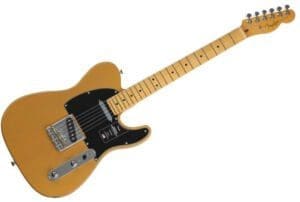

Specifications
Body and Neck
The Telecaster features a solid ash or alder body with a classic single-cutaway design, ensuring a balanced and resonant tone. The maple neck with a comfortable “Modern C” profile enhances playability and is adorned with a smooth satin finish for effortless movement along the fretboard.
Pickups
Equipped with V-Mod single-coil pickups specially designed for the American Professional series, this guitar delivers vintage-inspired tones with enhanced clarity and articulation. The neck pickup provides warm, mellow tones perfect for soulful country melodies, while the bridge pickup delivers the distinctive twang required for classic country rhythms.
Electronics
The Telecaster includes a treble bleed circuit that maintains clarity even when reducing the volume, preserving the nuances of your country-style playing. The three-way pickup switch allows seamless switching between neck, bridge, or a combination of both pickups, offering a wide array of sonic possibilities.
Hardware
With its classic 3-saddle strings-through-body bridge, the Telecaster ensures optimal sustain and precise intonation. The guitar is equipped with Fender’s deluxe staggered tuning machines, providing enhanced tuning stability, which is crucial for live performances.
Aesthetics
The American Professional Telecaster exudes timeless elegance with its gloss urethane finish on the body and tasteful pickguard, making it a visually appealing instrument on any country stage.
The Fender American Professional Telecaster embodies the soulful twang and warmth that define country music. Its comfortable playability, tonal versatility, and enduring design make it an exceptional choice for country players seeking an instrument that captures the heart and soul of this genre.
Rating: 5/5 stars
From Beginner to Pro: How to Choose the Perfect Electric Guitar in 2024
Whether you’re a beginner or a Pro guitarist looking to upgrade your electric guitar, choosing the perfect axe can be daunting. With so many options available on the market, it’s important to consider various factors such as sound, playability, and style to ensure you find the right fit when trying to find that perfect guitar for you.
In this guide, we’ll take you from beginner to pro, walking you through some important steps to help you make an informed decision. From understanding the different types of electric guitars to exploring the latest technological advancements, we’ll equip you with the knowledge and expertise to navigate through the vast array of options available.
Types of Electric Guitars
There are three main types to consider when it comes to electric guitars: solid body, hollow body, and semi-hollow body. Each type has its own unique characteristics that can greatly impact the sound and playability of the instrument.
Solid Body Electric Guitars
Solid-body electric guitars are the most common type and are known for their versatility and solid construction. These guitars are made from a single block of wood, which helps to eliminate unwanted feedback and produce a bright, focused tone. Solid-body guitars are commonly used in rock, metal, and blues genres due to their ability to handle high gain and distortion.
Hollow Body Electric Guitars
Hollow-body electric guitars have a chambered body, which creates a warm, resonant tone. These guitars are favored by jazz and blues players for their rich, full-bodied sound. The hollow body design also allows for a more acoustic-like tone when played unplugged. However, it’s important to note that hollow-body guitars are prone to feedback at high volumes and may not be suitable for genres that require high gain or distortion.
Semi-Hollow Body Electric Guitars
Semi-hollow body electric guitars balance the solid body and hollow body designs. These guitars have a solid center block running through the body, which helps to reduce feedback while still maintaining some of the warmth and resonance of a hollow-body guitar. Semi-hollow body guitars are a popular choice for players who want the best of both worlds, combining the versatility of a solid body with the rich tone of a hollow body.
Factors to Consider When Choosing an Electric Guitar
Choosing the perfect electric guitar requires careful consideration of several factors. By considering these factors, you can ensure that you find a guitar that suits your budget, playing style, and musical genre.
Budget
Setting a budget is important before diving into the world of electric guitars. Electric guitars come in a wide range of prices, from affordable entry-level models to high-end professional instruments. Setting a budget will help you narrow down your options and focus on guitars that are within your price range.
Playing Style
Your playing style will also significantly determine the type of electric guitar that suits you best. If you’re into heavy rock or metal, you may prefer a guitar with humbucker pickups for a thicker, more aggressive tone. On the other hand, if you’re into blues or jazz, you might lean towards single-coil pickups for their clear, articulate sound. Consider the genre of music you play and choose a guitar that complements your playing style.
Musical Genre
Different musical genres have different requirements when it comes to electric guitars. For example, if you’re primarily a rhythm guitarist in a rock band, you may want a guitar with a solid body and a powerful tone. If you’re a lead guitarist in a jazz band, a hollow-body guitar with a warm, mellow tone might be more suitable. Consider the genre of music you play and choose a guitar that fits the sonic characteristics of that genre.
Understanding Guitar Components
To make an informed decision when choosing an electric guitar, it’s important to understand the various components of the instrument. Here are the key components you should be familiar with:
Body
The body of an electric guitar is typically made from wood and contributes to the overall tone and resonance of the instrument. Different types of wood can produce different tonal characteristics, so it’s worth considering the body material when choosing a guitar.
Popular body woods include mahogany, alder, ash, and maple.
Neck
The neck of an electric guitar is where the fretboard and strings are located. It’s important to consider the neck profile and width, as this can greatly impact the instrument’s playability. Some players prefer a slim, fast neck for shredding solos, while others prefer a thicker neck for added stability and sustain.
Pickups
Pickups are responsible for capturing the strings’ vibrations and converting them into an electrical signal that can be amplified. There are two main types of pickups: single-coil and humbucker. Single-coil pickups are known for their bright, clear tone, while humbuckers produce a thicker, more powerful sound. Some guitars come with a combination of both types, offering greater versatility.
Hardware
The hardware of an electric guitar includes the bridge, tuners, and controls. The bridge affects the intonation and stability of the guitar. Tuners allow you to adjust the pitch of the strings. The controls typically include volume and tone knobs and pickup selectors, which allow you to fine-tune your sound.
Popular Electric Guitar Brands and Models
When it comes to electric guitars, there are several reputable brands that have earned a solid reputation for their quality and craftsmanship. Here are some of the most popular electric guitar brands and models to consider:
Fender Stratocaster
The Fender Stratocaster is a timeless classic that countless guitar legends have played. Known for its iconic double-cutaway design and versatile tone, the Stratocaster is a favorite among rock, blues, and pop guitarists.
Gibson Les Paul
The Gibson Les Paul is another legendary guitar that has become synonymous with rock music. With its thick, sustain-rich tone and stylish design, the Les Paul has been a staple in the arsenal of many iconic guitarists.
PRS Custom 24
The PRS Custom 24 is a modern classic with a perfect balance of vintage and modern features. With its comfortable playability and versatile tone, the Custom 24 has gained popularity among many players.
Ibanez RG
The Ibanez RG series is known for its fast, shredder-friendly necks and aggressive tone. If you’re into heavy rock or metal, the RG series offers many options to suit your needs.
These are just a few examples of popular electric guitar brands and models. It’s important to try out different guitars and find the one that feels and sounds right for you.
Trying Out Electric Guitars
We understand that you might not be able to travel to a guitar store or show, but we want to make you aware regardless.
When it comes to choosing an electric guitar, nothing beats trying it out in person. Visiting local guitar stores or attending guitar shows are a great way to test out different guitars and get a feel for their playability and sound.
Local Guitar Stores
Local guitar stores often have a wide selection of electric guitars available for you to try out. Take the time to play different models and see how they feel in your hands. Pay attention to the neck profile, weight, and overall guitar comfort. Don’t be afraid to ask the staff for assistance and guidance.
Guitar Shows
Guitar shows are another great way to trya wide range of electric guitars in one place. These events often feature various vendors and exhibitors showcasing their latest models. Guitar shows can be a fun and immersive experience where you can try out guitars from different brands and compare their features and tones.
Online Resources for Researching and Comparing Electric Guitars
Trying out guitars in person is essential. Online resources can also be valuable for researching and comparing electric guitars. Here are some websites and platforms that can help you in your search:
Manufacturer Websites
Most electric guitar manufacturers have detailed product information and specifications available on their websites. Visiting these websites can give you a deeper understanding of the available models and features.
YouTube Reviews and Demos
YouTube is a treasure trove of electric guitar reviews and demos. Many guitarists and channels specialize in reviewing and demonstrating different guitars, allowing you to hear the sound and see the features of various models.
Online Forums and Communities
Online forums and communities, such as the Gearslutz or Ultimate Guitar forums, are great places to connect with fellow guitarists and seek advice. These platforms provide a wealth of information and insights from experienced players.
Important Accessories for Electric Guitar Players
In addition to the guitar itself, there are several accessories that are essential for electric guitar players. These accessories can greatly enhance your playing experience and help you achieve the desired tone and sound.
Amplifiers
A good amplifier is crucial for electric guitar players. Amplifiers come in various sizes and power ratings. Choosing one that suits your needs is important. Consider the type of music you play, the venues you perform in, and your budget when selecting an amplifier.
Effects Pedals
Effects pedals allow you to modify and shape your guitar’s sound. There are countless pedals to choose from, from distortion and overdrive to delay and reverb. Start with a few essential pedals that suit your playing style and experiment from there.
Cables and Connectors
High-quality cables and connectors are important for maintaining a clean and reliable signal from your guitar to your amplifier. Invest in durable cables and connectors to avoid unwanted noise and interference.
Guitar Straps and Stands
Guitar straps and stands are essential for playing comfortably and storing your guitar safely. Choose a strap that provides good support and adjustability. Also, we recommend that you invest in a sturdy stand to keep your guitar secure when not in use.
Tips for Maintaining and Caring for Your Electric Guitar
Once you’ve chosen the perfect electric guitar, taking proper care of it is important. That should ensure its longevity and optimal performance. Here are some tips for maintaining and caring for your electric guitar:
Clean and Polish Regularly
Regularly clean and polish your guitar to keep it looking and sounding its best. Use a soft cloth to wipe away any dust or fingerprints, and apply guitar polish to keep the finish in top condition.
Change Strings Regularly
Strings can lose their brightness and tone over time. Remember, it’s important to change them regularly. The frequency of string changes will depend on how often you play and the type of strings you use. Changing strings every 2-3 months or sooner is a good idea if they become dull or corroded.
Store in a Suitable Environment
Store your guitar in a suitable environment to protect it from temperature and humidity extremes. Avoid leaving it near windows or in direct sunlight, as this can cause damage to the finish and wood.
Get a Professional Setup
A professional setup can greatly improve the playability and performance of your electric guitar. Take your guitar to a qualified technician who can adjust the neck, bridge, and intonation to ensure optimal playability.
Conclusion
Choosing the perfect electric guitar requires careful consideration of a number of factors. By understanding the different types of electric guitars, considering your budget, playing style, and musical genre, and exploring the various components and accessories, you can find the instrument that suits you best and get it right the first time.
Remember to try out guitars in person if you can, utilize online resources for research, and take proper care of your guitar to ensure its longevity.
Transparency disclosure: Some of the links in this post are affiliate links, meaning that I may earn a commission if you click on a link and make a purchase. This commission comes at no extra cost to you. We only recommend products and services that I believe are helpful and valuable, and we never let the potential for a commission influence our recommendations.




